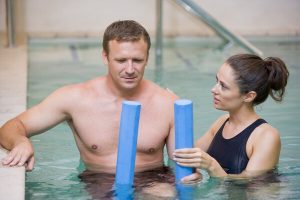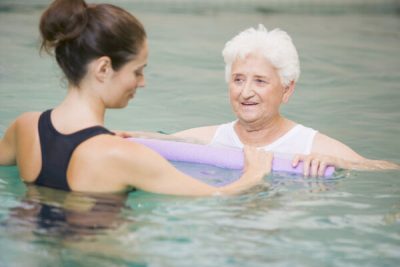What is hydrotherapy?
Hydrotherapy quite literally translates to ‘therapy in the water’. It is used as a form of rehabilitation for a range of injuries and conditions. While a hydrotherapy pool is typically between 33 and 36 degrees and fairly shallow, these exercises can be done in water of any temperature and depth. The warm water is pain-relieving and allows participants to stay in the water for the duration of their exercises without getting cold.
How does it differ from other forms of exercise?
Hydrotherapy exercises, like all Physiotherapy-based exercises, are tailored to a person’s individual needs and goals. The exercises tend to be very gentle and repetitive, to focus on endurance and strength without causing undue fatigue. Hydrotherapy is considered gentle weight-bearing (unless exercises are performed whilst lying flat in the water). Weight-bearing exercise has been proven to have significant positive effects on bone density. While other weight-bearing exercise like walking or running may cause pain to inflamed or weakened joints, this provides a means of having these benefits while lessening the likelihood of discomfort.

What are the benefits of hydrotherapy?
There are many benefits, including the following:
- Gentle weight-bearing to improve or maintain bone health.
- The warm water provides natural pain-relief and increased circulation for those with compromised vascular health.
- The hydrostatic pressure of the water can be beneficial for those suffering lymphoedema, swelling or other fluid retention.
- The water creates a resistance in which to work against. This helps to improve muscle strength and endurance.
- Joints are able to be put through a pain-free range of movement.
- Exercise of any kind releases endorphins – the natural feel-good hormones.
- The movement of the water can challenge balance and proprioception (spacial awareness).
- Improved cardiovascular fitness.
- Increased circulation of white blood cells around the body which can improve immunity.
Who is Hydrotherapy suitable for?
It is suitable for a wide range of clients. Predominantly, the patients we refer tend to be those with the following conditions:
- Spinal, hip or knee arthritis.
- Bursitis of the shoulder, hip or knee.
- Chronic pain conditions such as fibromyalgia or low back pain.
- Foot or ankle injuries/conditions such as bunions.
- Conditions that affect mobility, i.e.Multiple Sclerosis, Parkinson’s Disease or following a stroke.
- Following a motor vehicle or motorbike accident.
Patients who have undergone these surgeries often do well with hydrotherapy:
- Joint replacement surgery (i.e. hip or knee).
- Spinal surgery such as laminectomy or discectomy.
- Fracture fixation surgery.
- Muscle, tendon or ligament repair surgery i.e. ACL repair.
- Foot/ankle surgeries such as hallux valgus correction or an ankle fusion.

Is Hydrotherapy unsuitable for anyone?
It should not be included as rehabilitation for people in the following situations:
- Open wounds.
- Prior to adequate surgical healing if post-operative. Your surgeon will be able to tell you if and when it should be commenced.
- Incontinence of the bladder or bowel.
- Uncontrolled epilepsy.
- Skin conditions that may be worsened with chlorinated water.
- Contagious cold/fever.
- Infectious skin conditions such as plantar warts.
It is not advised for pregnant women to swim/soak in hot water as this can raise core temperature and cause potential damage to the unborn baby. Some pools may be at a suitable temperature but please check with your pregnancy healthcare professional (Obstetrician, Midwife or GP) prior to commencement.
Example of a program following a knee replacement:
- Warm up with 4 x laps walking.
- 1 x lap walking leading with right leg.
- 1 x lap walking leading with left leg.
- 1 x lap walking backwards.
- 20 x mini squats.
- 20 x double-leg calf raises.
- 10 x left leg kicking out to side.
- 10 x right leg kicking out to side.
- 10 x right leg kicking out behind.
- 10 x left leg kicking out behind.
- Repeat program until hydrotherapy duration reaches 30 minutes.
If you have any questions about whether it may be helpful for you, speak with one of our Physiotherapists. They can help guide you and create a program tailored for your needs and goals.
~Ali Minichiello
Physiotherapist
Physiotherapist
Wanting to start a new exercise routine but lacking the motivation during the cooler months? This blog will help inspire you! https://portmelbournephysio.com.au/how-to-make-good-habits-stick-5-expert-tips/
Sources:
- https://australian.physio/
sites/default/files/tools/ Aquatic_Physiotherapy_ Guidelines.pdf - https://www.versusarthritis.
org/about-arthritis/ treatments/therapies/ hydrotherapy/ - https://connecthealth.org.
au/enews/why-water-works-4- hydrotherapy-health-benefits/ - https://www.physio.co.uk/
treatments/hydrotherapy/ hydrotherapy-for-orthopaedic- conditions.php - https://pubmed.ncbi.nlm.nih.
gov/19406293/ - https://www.nqphysio.com.au/
hydrotherapy-indications-and- contraindications/ - https://choose.physio/your-wellbeing/hydrotherapy

